

A

Source: WikiCommons
Australia entered World War II on 3 September 1939. On 14 September Prime Minister Robert Menzies announced that 40,000 members of the Militia would be called up for training and a 20,000-strong expeditionary force, designated the Second Australian Imperial Force, would be formed for overseas service. From there, Australians fought across numerous theatres of war, contributing to the war effort across the globe. Read through the resources below to learn more.
As part of the British Empire, Australia was among the first nations to declare war on Nazi Germany and between 1939 and 1945 nearly one million Australian men and women served in what was going to be World War II. Read through this website to learn more.
After Great Britain declared war on Germany on 3 September 1939, Australia raised a volunteer force, the Second Australian Imperial Force (AIF), and sent the 6th, 7th and 9th Divisions of the AIF overseas to support Britain. Despite long-held fears that Japan would enter the war on the side of the Germans, the Australian government also sent Royal Australian Air Force (RAAF) aircrews and a number of Royal Australian Navy (RAN) ships to fight for Britain. During the years 1939-1941, Australian soldiers, sailors and airmen fought the Germans, Italians and Vichy French in Europe, Egypt, Libya, Syria, the Lebanon, Greece, Crete and the Mediterranean.
When Japan entered the war in Malaya on 7/8 December 1941, the 8th Division AIF, together with a few Australian ships and aircraft, were there with other British Empire forces. In early 1942, the 6th and 7th Divisions from the Middle East together with RAN ships were ordered back to Australia to fight the Japanese in the Pacific. The 9th Division stayed in North Africa until early 1943 while many Australian airmen serving in both the RAAF and the Royal Air Force (RAF) remained to fight in Europe. Read through this website to learn more about Australia's role in World War II.
Almost a million Australians, both men and women, served in the Second World War. They fought in campaigns against Germany and Italy in Europe, the Mediterranean and North Africa, as well as against Japan in south-east Asia and other parts of the Pacific. Read through this website to learn more.
The figures in the table hereunder represent gross enlistments of war service personnel, plus permanent personnel at the beginning of the war, plus gross enlistments in the permanent forces. Particulars for the Navy and Air Force are as at 31st December, 1945, and for the Army as at 28th February, 1946. The term "gross enlistments" indicates that no deductions have been made because of discharges, dead, deserters, etc.
The Second World War was the first time Australians were conscripted to fight overseas. In November 1939 Prime Minister Robert Menzies announced that the existing reserve force, the Citizen Military Forces (CMF) or militia, would be bolstered by conscription. Read through this website to learn more.
This article looks at the role that industry in Australia played in the defeat of the Japanese.
Australia, by declaration, entered the conflict now known as World War 2 on 3 September 1939 – on the same day, and in unity with, Great Britain. Together with New Zealand, Australia was one of only two non-European nations to enter the war from its outset, and both countries remained actively involved when the documents of formal surrender were signed on 2 September 1945 - one day short of six long years of conflict. Read through this website to learn more.
The commemorative publication is part of a series; A Bitter Fate. It explores theatres of war and campaigns during the Second World War. The publication concentrates on Australia’s involvement in the Malaya and Singapore campaign. The campaign lasted from December 1941 to February 1942. The Allied forces then surrendered in Singapore.
This publication is a part of the series; Australians in the Pacific War. It briefly shares the history of Australia's defence against the Japanese from 1939-1945.
This publication is the first of a two-volume series, it focuses on the air attacks on Australia's northern coastline.

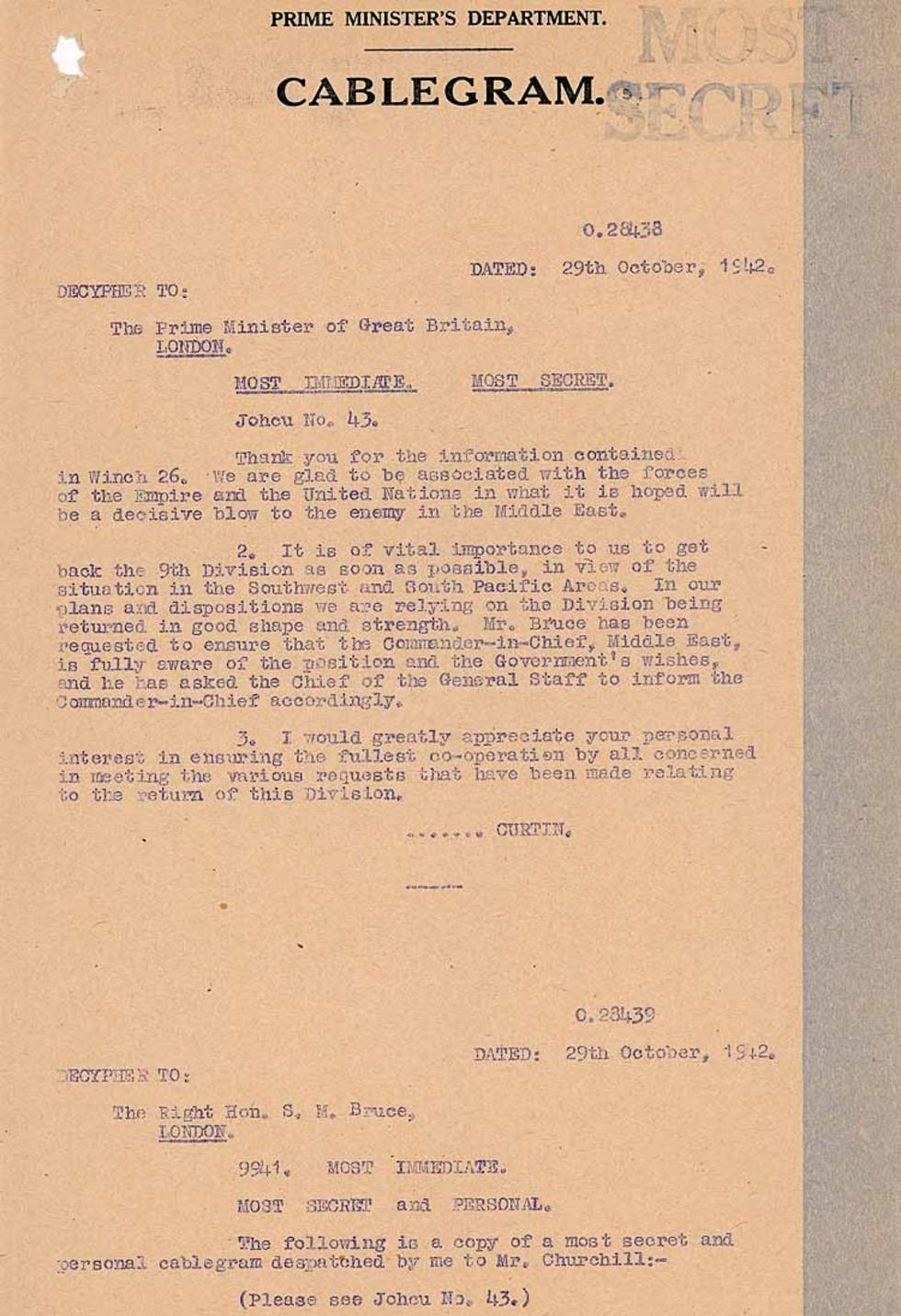
This is a cablegram from Australian Prime Minister John Curtin to his British counterpart, Winston Churchill, on 29 October 1942. Marking his message 'MOST IMMEDIATE' and 'MOST SECRET', Curtin tells Churchill it is of 'vital importance' that the 9th Division of the Australian Imperial Force (AIF), which has been fighting in North Africa, be returned to Australia as soon as possible. He states that Australia is relying on the division being returned 'in good shape and strength' to help fight Japanese forces, and he requests Churchill's help in ensuring this occurs.
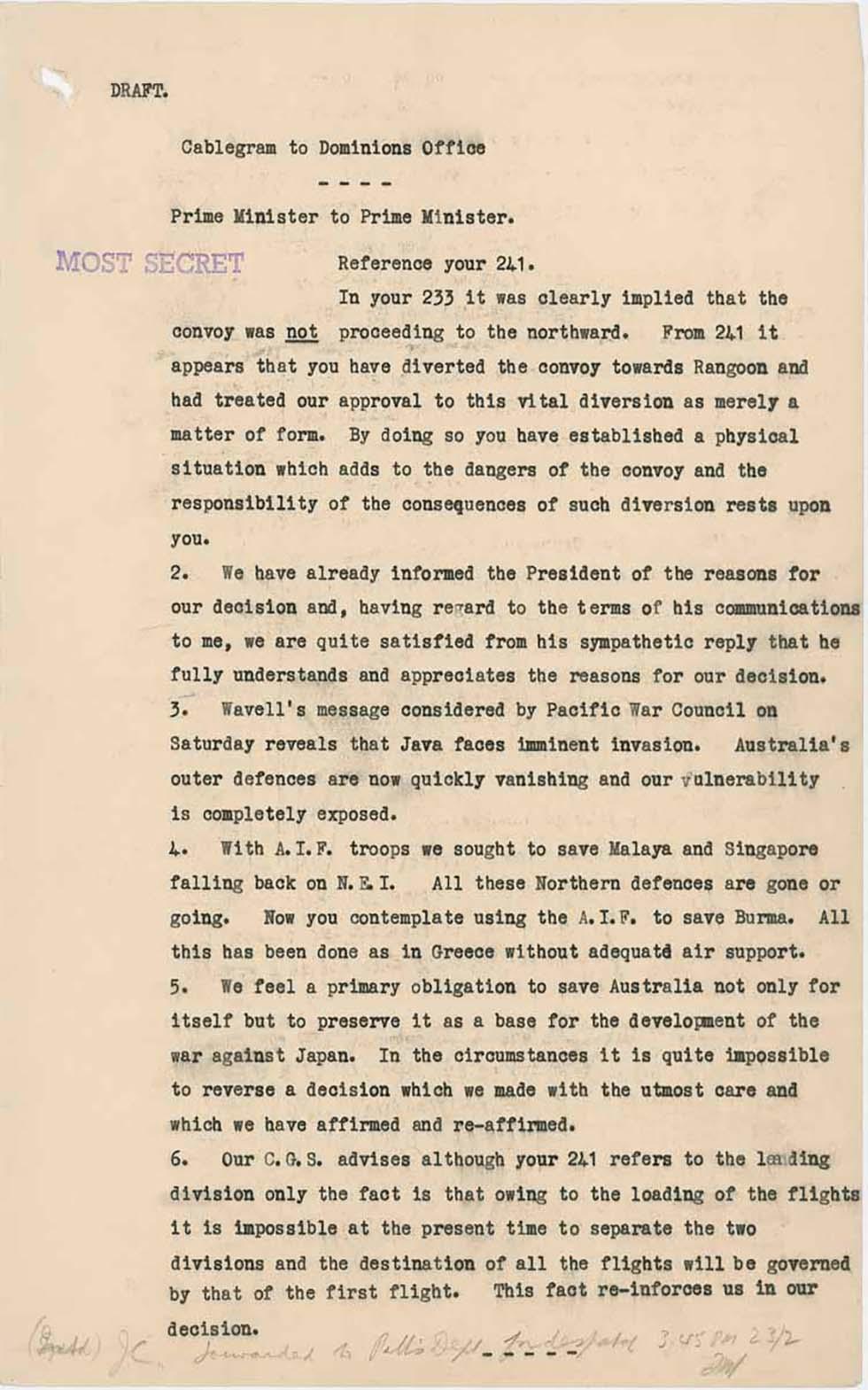
Marked 'most secret', this is the draft of a cablegram written by Australian Prime Minister John Curtin to his British counterpart, Winston Churchill, on 23 February 1942. Curtin points out that Churchill has ignored Australia's wishes by diverting ships carrying Australian troops towards Burma, apparently expecting Australia's approval as a matter of form. Curtin restates Australia's wish for the troops to be sent home, as Australia's 'outer defences' are quickly vanishing and the country's vulnerability is 'completely exposed'.
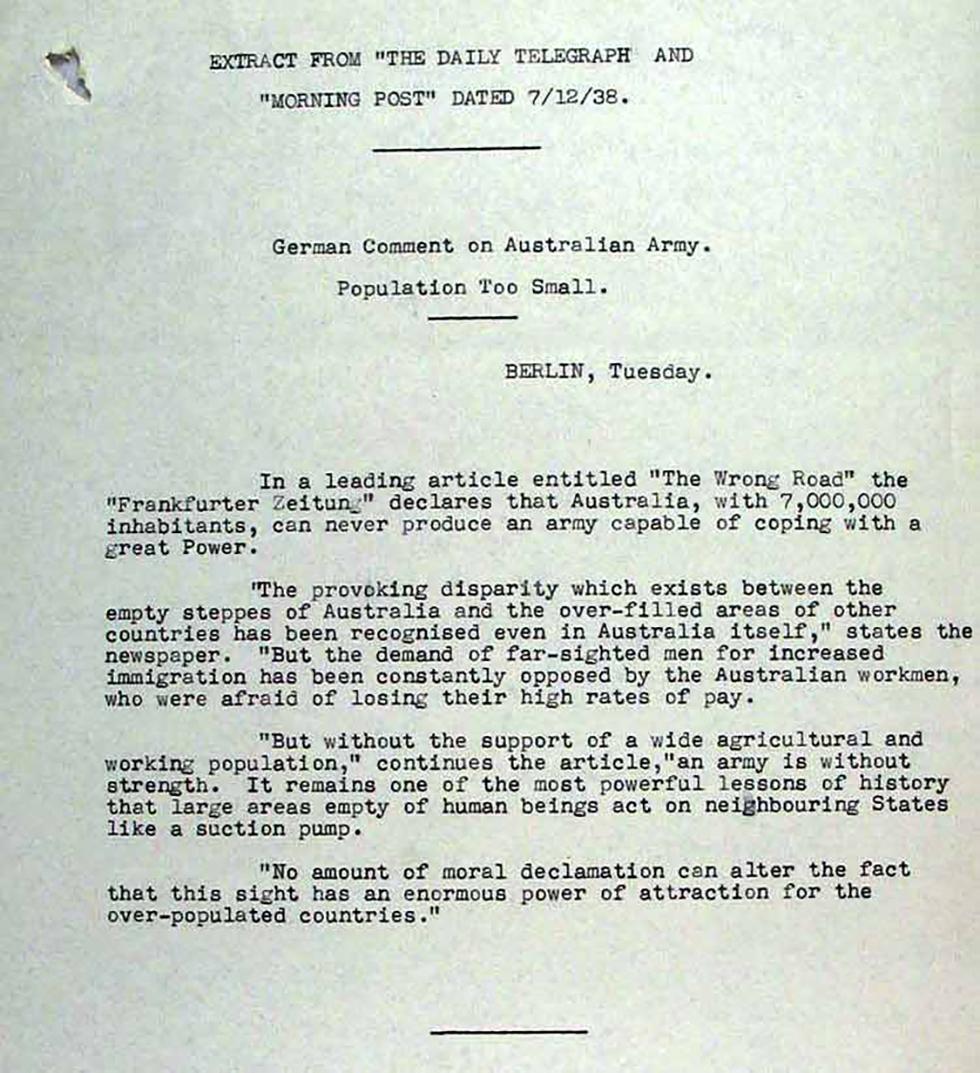
A document containing extracts from German newspapers regarding the Australian army.
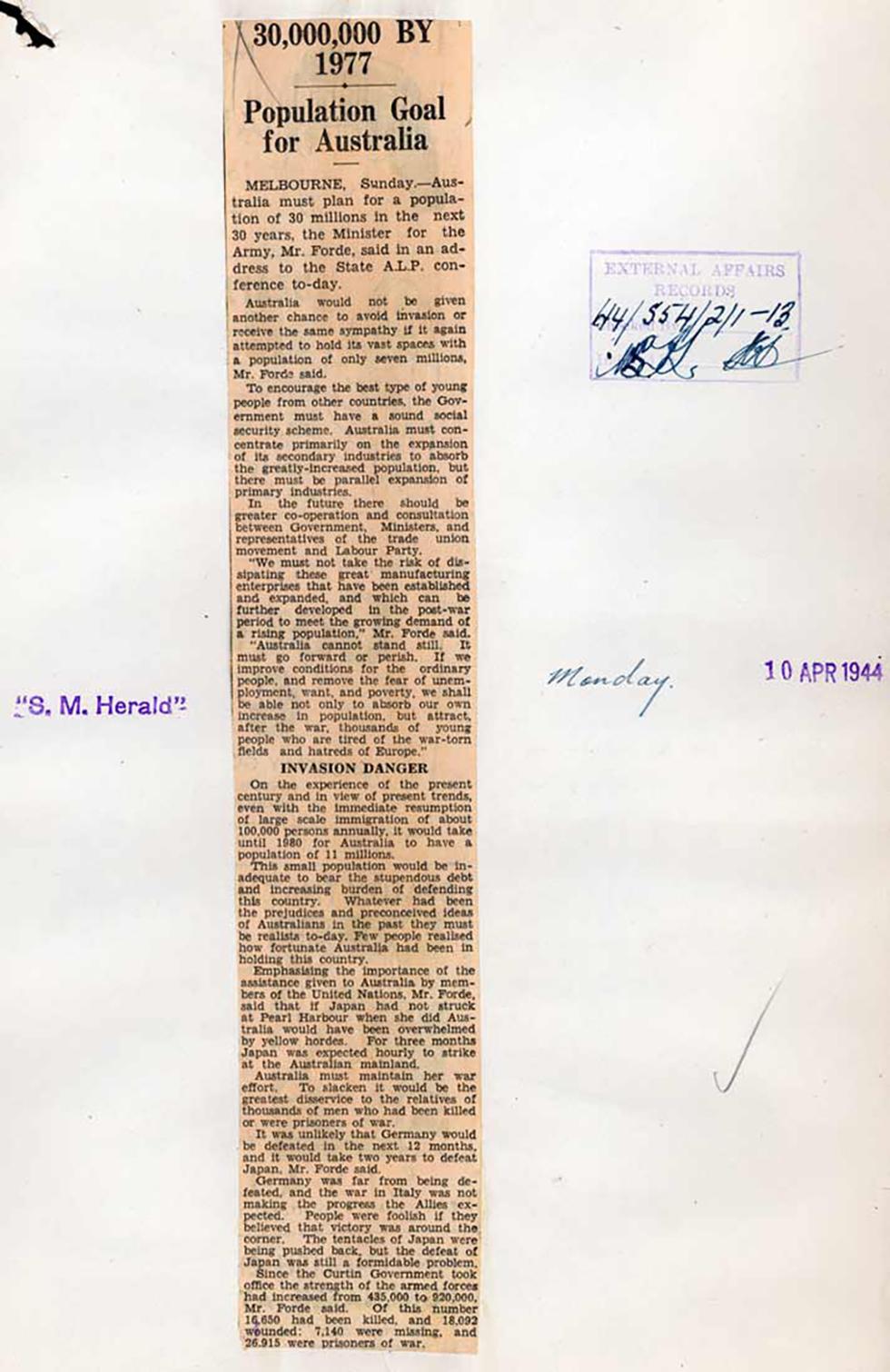
This 1944 article from the Sydney Morning Herald promotes a population goal of 30 million people by 1977 to protect Australia from invasion. It highlights Australia's fear of invasion.
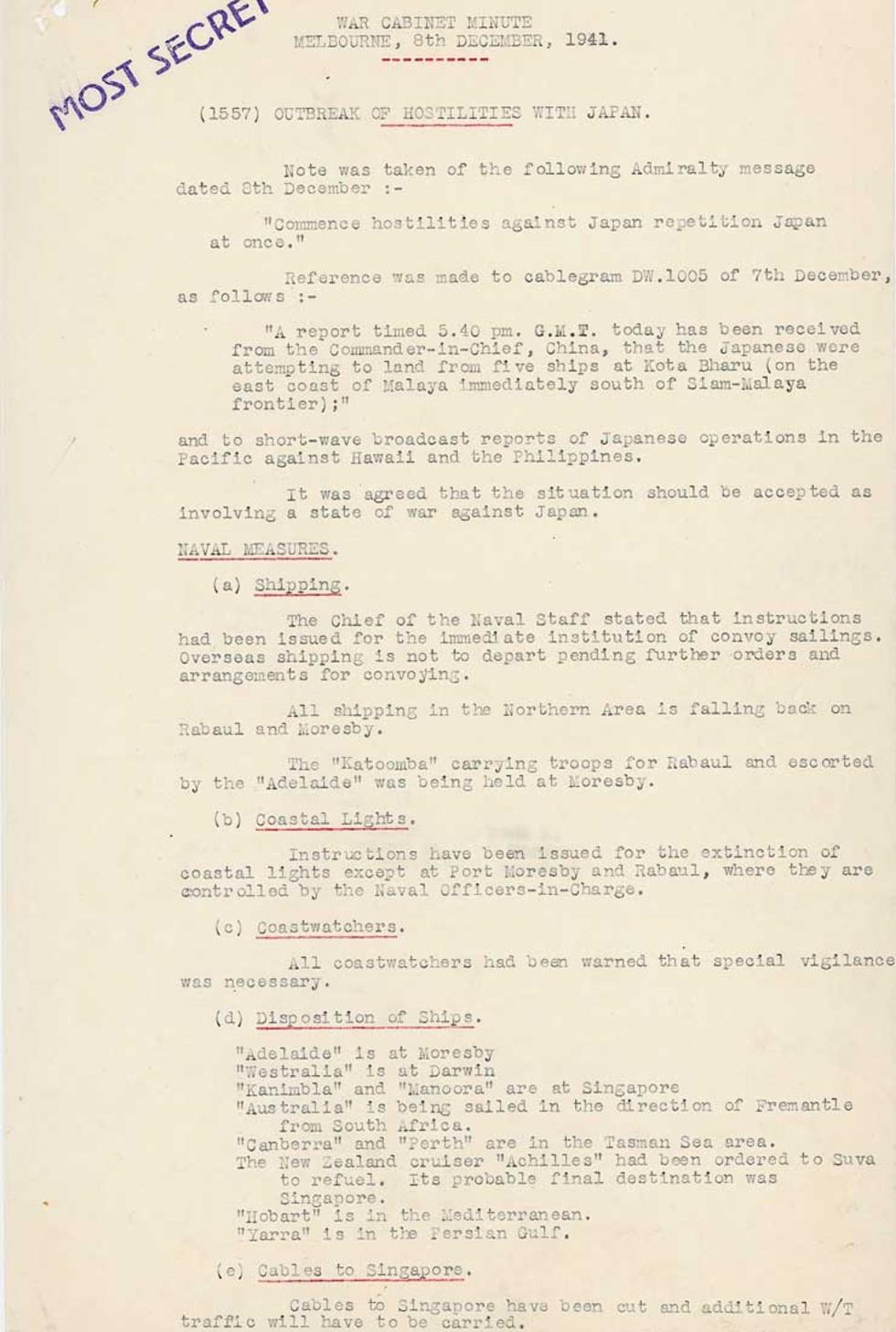
This is the record of discussions and decisions of a meeting of the Australian War Cabinet held in Melbourne on 8 December 1941. Stamped 'MOST SECRET', the record includes the Cabinet's decisions on the naval, army and air force measures to be put in place now that Australia was at war with Japan. It also canvasses the strategic situation in Asia, the actions to be taken in the Australian region, the need to accelerate munitions production, the protection of shipping, and the possibility of Japanese attacks on Australia and its territories.
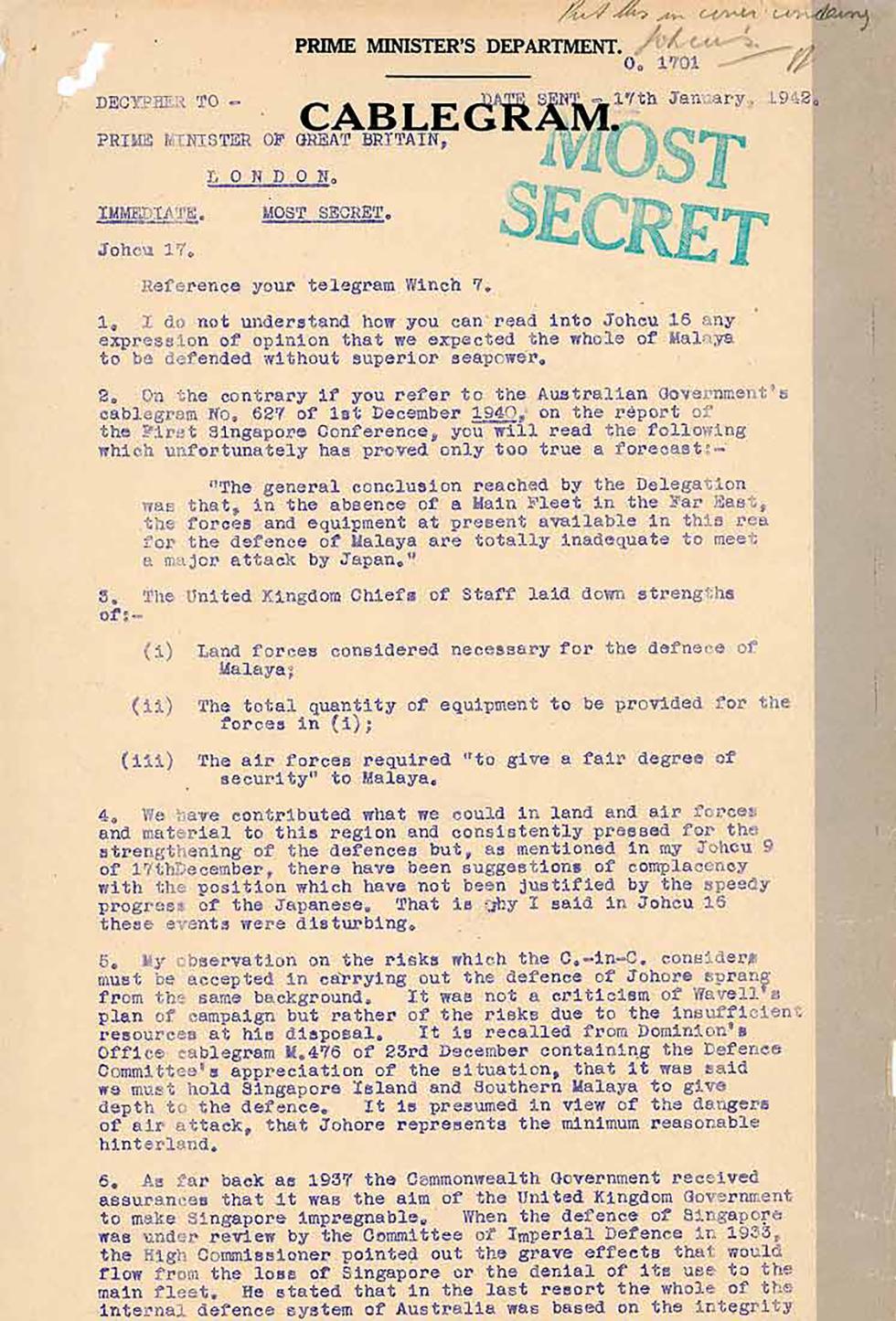
This is a two-page cablegram sent on 17 January 1942 in which Australian Prime Minister John Curtin makes his views on the level of British commitment to the defence of Singapore clear to his British counterpart, Winston Churchill. Marked 'IMMEDIATE' and 'MOST SECRET', the cablegram refers to past conferences, discussions and assurances on the security of Singapore. While he praises the people of Britain for their magnificent efforts, Curtin makes no apology for raising the issue of British air support and for focusing on the defence of Australia.
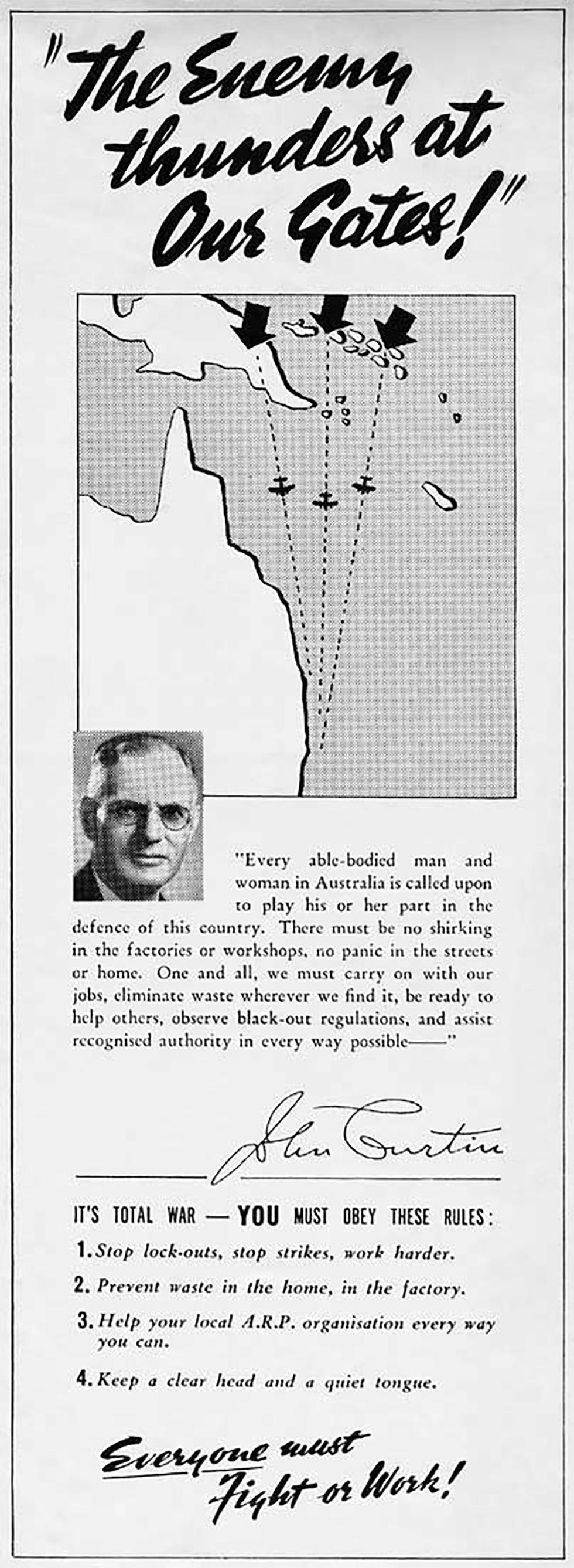
This is a black-and-white poster showing a map of Australia with arrows and planes coming down from Papua New Guinea and the headline 'The Enemy thunders at Our Gates'. There is a photo of Prime Minister John Curtin and a message from him, calling on Australians to play their part in the war effort.
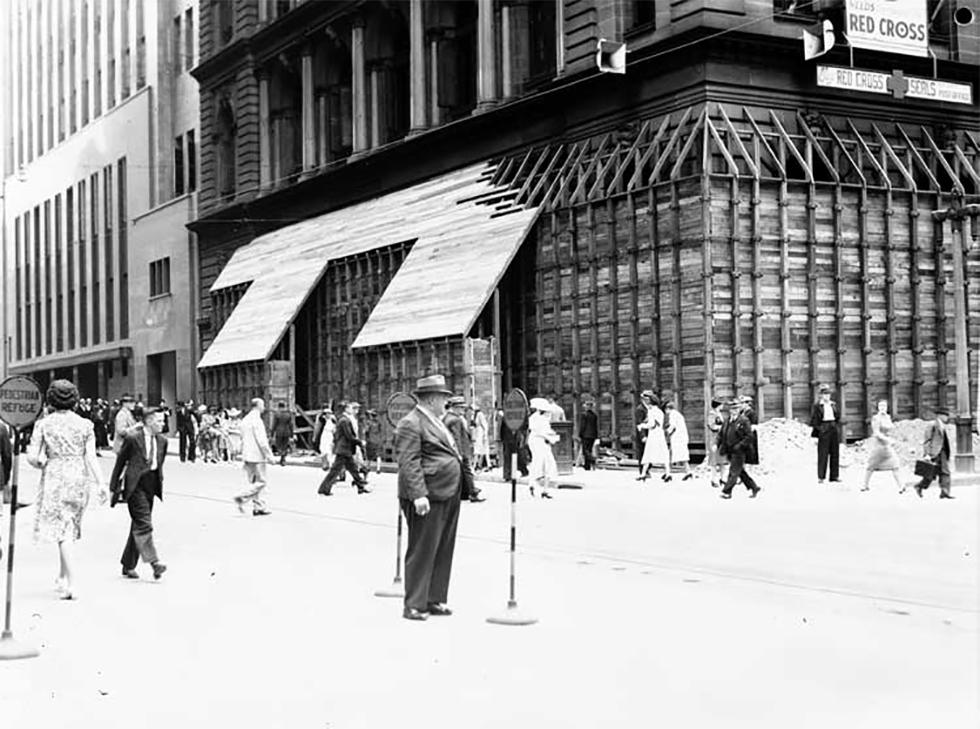
This is a black-and-white photograph showing the air raid protection erected around the old Sydney General Post Office on the corner of Pitt Street and Martin Place. The new post office building is also visible, as are Red Cross posters and signs for a pedestrian refuge (air raid shelter). People can be seen standing and walking in the streets.
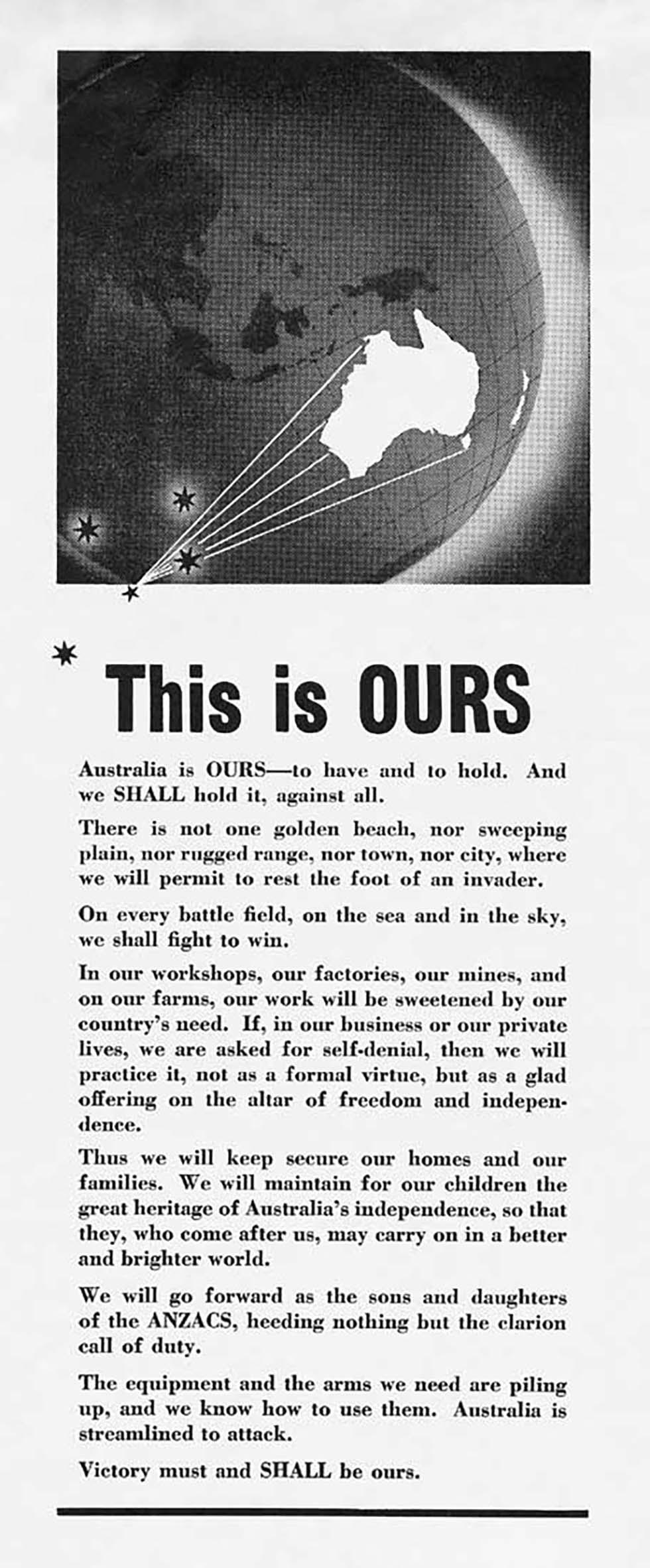
This is a black-and-white poster showing a map of the world on which Australia is highlighted and linked to the five stars of the Southern Cross. The poster is titled 'This is OURS', and its emotive text urges Australians to fight to win on the battlefield and at home.
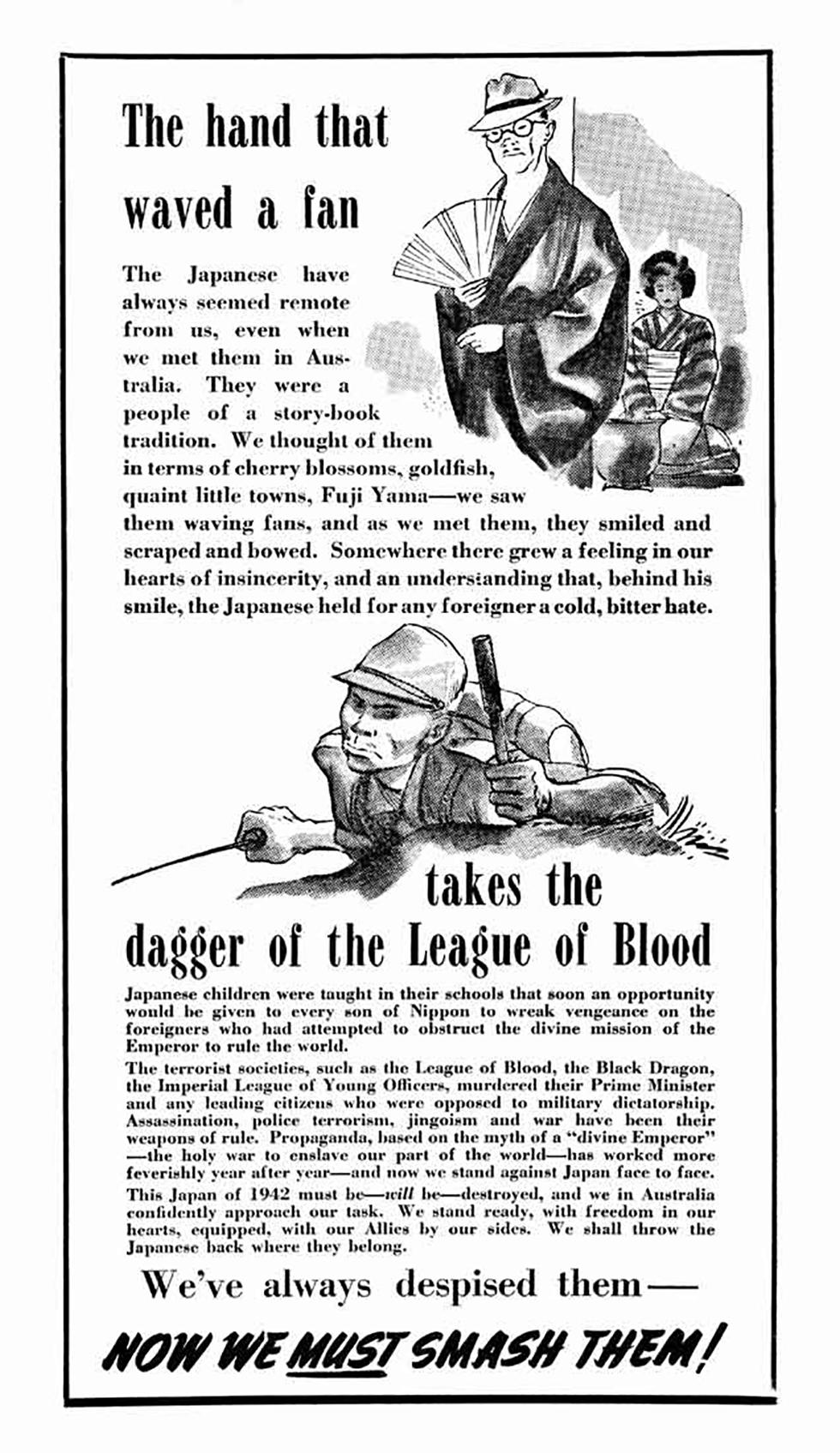
This is a black-and-white Australian propaganda poster with the heading 'The hand that waved a fan takes the dagger of the League of Blood'. At the bottom of the poster is the text 'We've always despised them - NOW WE MUST SMASH THEM! At the top of the poster, an illustration shows a Japanese man in traditional dress waving a fan, and, seated behind him, a woman in a kimono. A second illustration shows a Japanese soldier wielding a dagger and a sword.

This sound recording is an excerpt of a public address given by Australian Prime Minister John Curtin (1885–1945) on 8 December 1941 announcing Australia’s declaration of war on Japan. The complete speech outlines the government’s reasons for going to war; the threat posed by Japan to Australian interests; the diplomatic efforts by the United States and its allies to secure peace; an appeal for public support; and an assurance that the Australian Government will provide for the safety of the nation. The speech was originally broadcast by the Australian Broadcasting Commission.
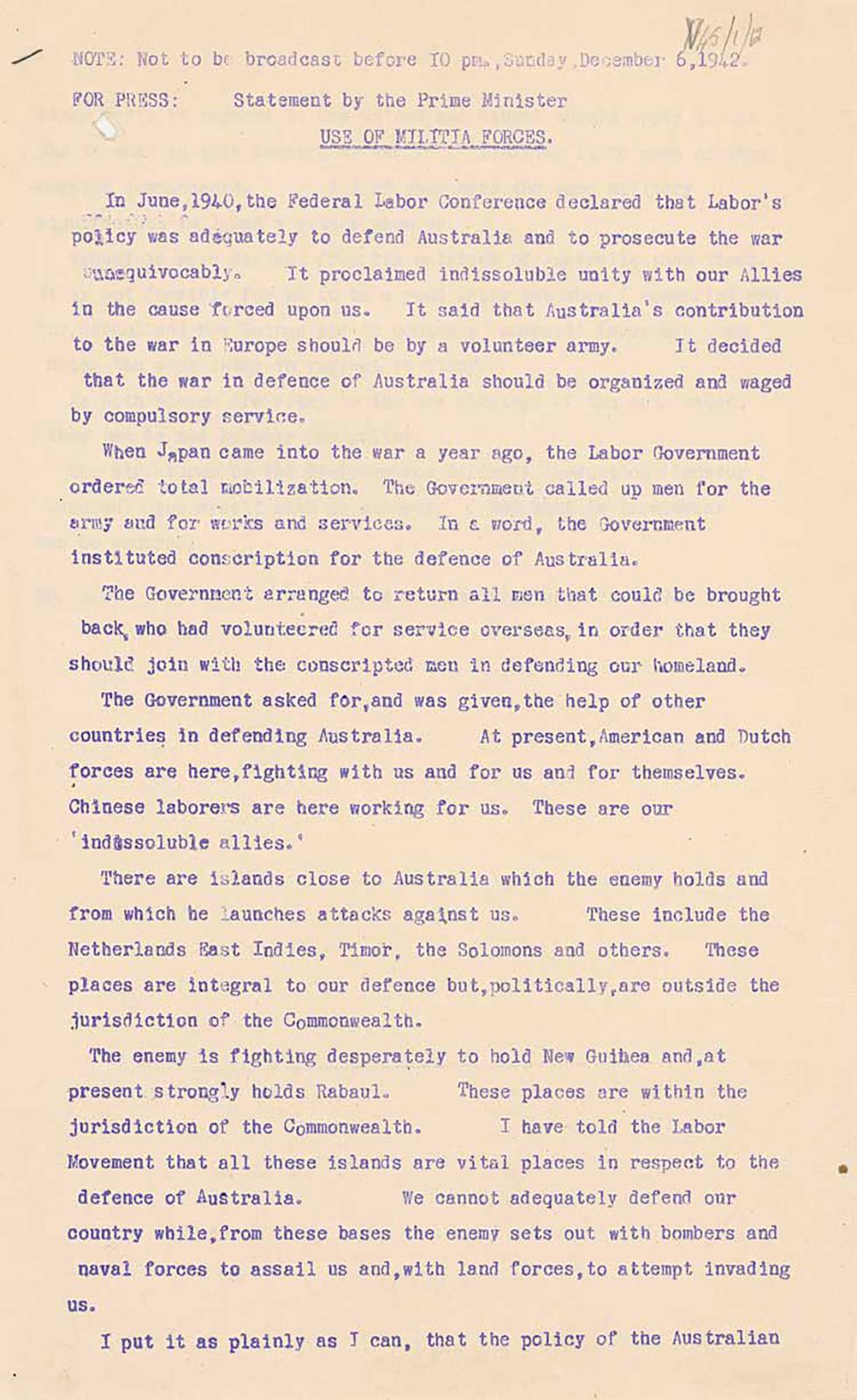
This is a press statement issued by Prime Minister John Curtin (1885–1945) on 6 December 1942. It relates to Australia's current position in the Pacific theatre of World War II, the country's relationships with and responsibilities to her allies, particularly the United States, and conscription for overseas service. It is part of an extensive Prime Minister’s Department file on the use of militia outside Australia.


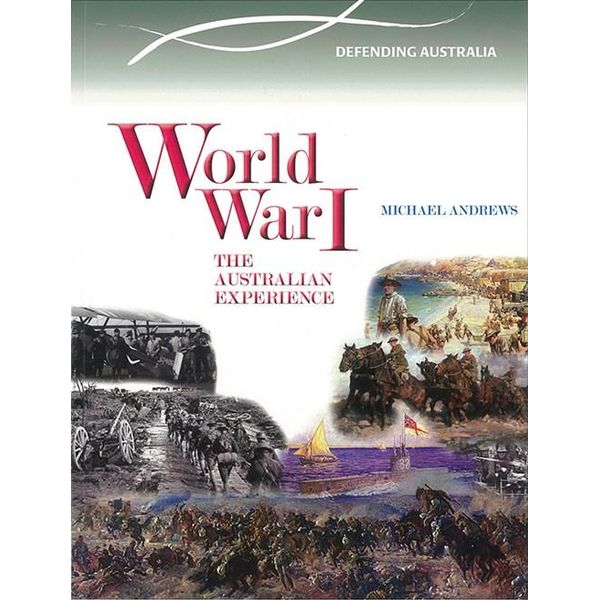 World War II : the Australian experience
by
World War II : the Australian experience
by